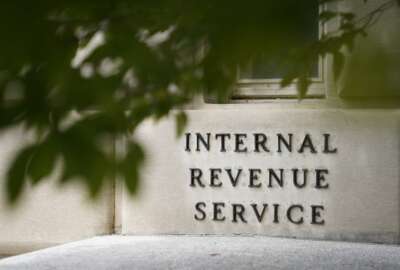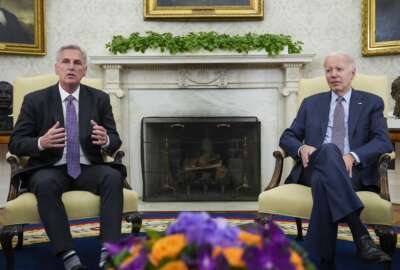
White House outlines plan for green government spending spared by debt ceiling cuts
The Biden administration’s long-term goals to eliminate carbon emissions from federal buildings and vehicles remain unscathed, as part of a bipartisan deal to cut...
The Biden administration’s long-term goals to eliminate carbon emissions from federal buildings and vehicles remain unscathed, as part of a bipartisan deal to cut government spending in exchange for raising the debt ceiling.
Heather Boushey, a member of the White House Council of Economists, said Wednesday that lawmakers spared the environmental pieces of the Inflation Reduction Act from proposed cuts.
“There were not changes, there was no paring back. And I think that was certainly part of the conversation over the course of this year, and some concerns there. So that is certainly good news,” Boushey said Wednesday at a sustainability conference hosted by The Economist.
Boushey, however, said she’s wary about the IRS facing substantial cuts to its modernization fund, as part of a deal between the White House and House Republicans to raise the debt ceiling and avoid a first-ever government default.
The Biden administration and Republican lawmakers are prepared to cut $20 billion from funds the IRS received in the Inflation Reduction Act — about a quarter of the nearly $80 billion received to spend over the next decade.
The Senate passed the budget cuts package late Thursday night, which now heads to President Joe Biden to sign into law. The House passed the bill on Wednesday.
The Congressional Budget Office expects the IRS would use those funds to bring in $124 billion in additional revenue over the next decade, and would have gone a long way in offsetting the Inflation Reduction Act’s $369 billion in federal spending on energy security and climate change.
“I’m both concerned that, if we don’t have the IRS doing its job, then we aren’t going to get the revenue that we need,” Boushey said. “And I think that sends a signal that that’s maybe a cookie jar that we can keep pulling from. So I’m looking down the pipeline, and I think we want to make sure that the staff and the workers at the IRS understand that we understand how important their role is.”
Boushey said Treasury Department officials are confident that the IRS will still be able to accomplish its short-term modernization goals under the Inflation Reduction Act, but it remains unclear whether the anticipated spending cuts will impact the IRS’s ability to bring in additional revenue.
“As people who are concerned about climate, given how much of this is being done through the IRS, we need to be making sure that that is on our checklist of agencies that we are watching very closely,” she said.
The Biden administration, meanwhile, is moving ahead on its decades-long vision to eliminate carbon emissions from federal buildings and vehicles.
To achieve the administration’s goal of reaching net-zero greenhouse gas emissions across all federal operations by 2050 and a 65% reduction by 2030, agencies are looking at ways to make their buildings and vehicles more sustainable.
Federal Chief Sustainability Officer Andrew Mayock said the federal government’s role as the biggest U.S. buyer of goods and services and biggest consumer of electricity, as well as the owner of the biggest building portfolio and vehicle fleet, is helping to drive investments in sustainability.
“As that big buyer, we’ve got the mandate from the president in [his] first week to go utilize the power of the footprint across those purchasing priorities that I just mentioned, to go and make sure that we’re a catalyst to the clean-energy economy,” Mayock said.
The federal government owns a portfolio of more than 300,000 federal buildings and a 600,000-vehicle fleet. It also purchases more than $650 billion in goods and services each year.
Brenda Mallory, chairwoman of the White House Council on Environmental Quality, said agencies are making strong progress toward the Biden administration’s goals.
Mallory highlighted the Postal Service’s plans to use Inflation Reduction Act funds to have 66,000 electric vehicles in its next-generation fleet by 2028. USPS, under this plan, would have one of the nation’s largest electric vehicle fleets.
“Our administration is laser-focused on leveraging the power of our footprint,” Mallory said.
The Biden administration expects its major investments in its green government goals will lead to cost savings in later years.
A report released last month from consulting and technology services provider ICF estimates the federal government could save nearly $6 billion over 15 years, by switching to a fleet of electric vehicles.
Those savings account for the upfront investment of about $4.6 billion, which includes charging hardware and installation costs. The report estimates that electrifying the entire federal fleet would avoid nearly 1.7 million metric tons of greenhouse gas emissions every year.
The report estimates the federal fleet across all civilian and defense agencies travels more than 4 billion miles a year, the equivalent of driving around the circumference of the Earth 160,000 times. Agencies spend about $4.5 billion on fleet operations every year.
Copyright © 2025 Federal News Network. All rights reserved. This website is not intended for users located within the European Economic Area.
Jory Heckman is a reporter at Federal News Network covering U.S. Postal Service, IRS, big data and technology issues.
Follow @jheckmanWFED
Related Stories





